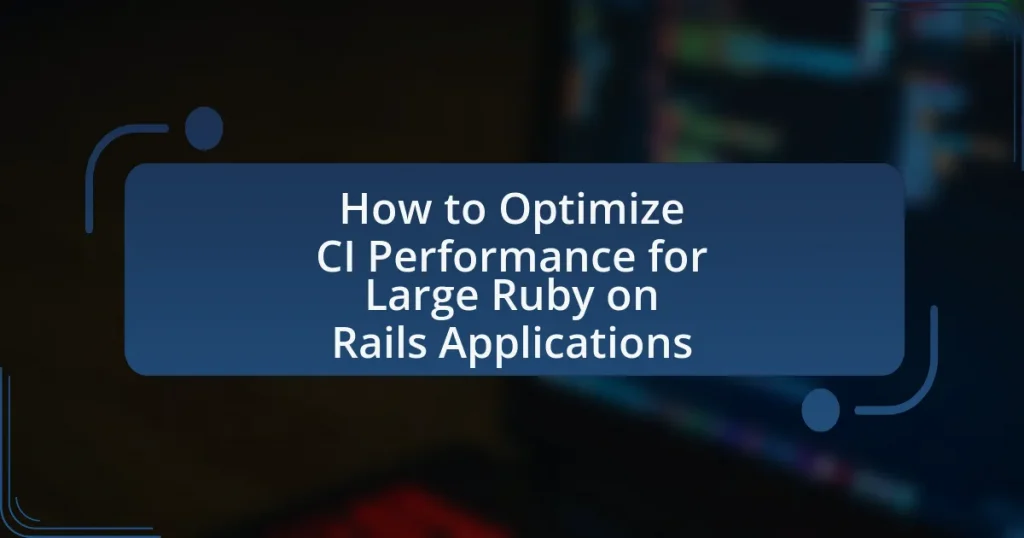Continuous Integration (CI) performance optimization for large Ruby on Rails applications focuses on enhancing the efficiency and speed of CI processes. Key strategies include parallel testing, caching mechanisms, and optimizing test suites, which can significantly reduce build times and improve development productivity. The article discusses the impact of CI performance on the development process, key metrics for measurement, challenges faced by large applications, and practical strategies for optimization. It also highlights the role of infrastructure, cloud services, and CI/CD tools in supporting these optimizations, ultimately emphasizing the importance of maintaining high CI performance for rapid and reliable software delivery.
What is CI Performance Optimization for Large Ruby on Rails Applications?
CI Performance Optimization for Large Ruby on Rails Applications involves enhancing the efficiency and speed of Continuous Integration (CI) processes specifically tailored for Ruby on Rails projects. This optimization can be achieved through strategies such as parallel testing, where tests are executed simultaneously across multiple environments, significantly reducing overall test execution time. Additionally, utilizing caching mechanisms for dependencies and test results can further streamline the CI pipeline. According to a study by the Continuous Delivery Foundation, organizations that implement CI performance optimization techniques can reduce build times by up to 50%, leading to faster feedback loops and improved development productivity.
How does CI performance impact the development process?
CI performance significantly impacts the development process by influencing the speed and efficiency of code integration and testing. High CI performance reduces the time developers spend waiting for builds and tests to complete, allowing for quicker feedback on code changes. This rapid feedback loop enhances collaboration among team members, as developers can address issues immediately, leading to improved code quality and reduced integration problems. Studies show that teams with optimized CI processes can achieve deployment frequencies up to 200 times more than those with slower CI systems, demonstrating a direct correlation between CI performance and overall development productivity.
What are the key metrics for measuring CI performance?
The key metrics for measuring Continuous Integration (CI) performance include build success rate, build time, test pass rate, and deployment frequency. Build success rate indicates the percentage of builds that pass without errors, reflecting the stability of the codebase. Build time measures the duration taken to complete a build, which impacts developer productivity. Test pass rate shows the percentage of tests that pass during the CI process, serving as an indicator of code quality. Deployment frequency tracks how often code changes are deployed to production, highlighting the efficiency of the CI pipeline. These metrics collectively provide insights into the effectiveness and reliability of the CI process in large Ruby on Rails applications.
How does CI performance affect deployment frequency?
CI performance directly impacts deployment frequency by determining how quickly code changes can be validated and integrated into the main codebase. High CI performance, characterized by faster build times and efficient test execution, enables teams to deploy more frequently, as they can quickly identify and resolve issues. For instance, organizations that implement optimized CI processes often report deployment frequencies increasing by up to 50%, as seen in studies like the “State of DevOps Report,” which highlights that high-performing teams deploy code 200 times more frequently than their lower-performing counterparts. This correlation underscores the importance of CI performance in facilitating rapid and reliable deployments.
Why is optimizing CI performance crucial for large applications?
Optimizing CI performance is crucial for large applications because it directly impacts development speed and software quality. In large applications, continuous integration (CI) processes can become bottlenecks due to the volume of code changes and extensive testing requirements. Efficient CI performance reduces build times, enabling developers to receive immediate feedback on their code, which accelerates the development cycle. According to a study by the DevOps Research and Assessment (DORA) team, high-performing teams that optimize CI practices can achieve deployment frequencies of multiple times per day, compared to lower-performing teams that may deploy only once every few weeks. This optimization not only enhances productivity but also improves the overall reliability of the application by allowing for quicker identification and resolution of issues.
What challenges do large Ruby on Rails applications face in CI?
Large Ruby on Rails applications face several challenges in Continuous Integration (CI), primarily due to their complexity and size. These challenges include long build times, which can exceed acceptable limits, leading to delays in feedback for developers. Additionally, dependency management becomes increasingly difficult as the number of gems and libraries grows, often resulting in version conflicts and compatibility issues. Furthermore, the extensive test suite required for comprehensive coverage can slow down the CI process, making it harder to maintain quick iterations. Finally, resource consumption during CI runs can be significant, requiring substantial infrastructure to handle the load efficiently. These factors collectively hinder the effectiveness of CI in large Ruby on Rails applications.
How can poor CI performance hinder team productivity?
Poor Continuous Integration (CI) performance can significantly hinder team productivity by causing delays in the development process. When CI systems are slow or unreliable, developers spend more time waiting for builds and tests to complete, which reduces the time available for actual coding and feature development. According to a study by the DevOps Research and Assessment (DORA) team, high-performing teams that utilize effective CI practices can deploy code 46 times more frequently than low-performing teams, highlighting the impact of CI efficiency on overall productivity. Additionally, frequent build failures can lead to frustration and decreased morale among team members, further exacerbating productivity issues.
What strategies can be employed to optimize CI performance?
To optimize Continuous Integration (CI) performance, implementing parallel testing is essential. This strategy allows multiple tests to run simultaneously, significantly reducing the overall testing time. For instance, using tools like RSpec and Capybara in a Ruby on Rails environment can facilitate parallel execution, leading to faster feedback loops. Additionally, optimizing the test suite by removing redundant tests and focusing on high-value tests can further enhance performance. Research indicates that organizations adopting parallel testing can achieve up to a 70% reduction in CI build times, demonstrating the effectiveness of this approach.
How can test suite optimization improve CI performance?
Test suite optimization can significantly improve Continuous Integration (CI) performance by reducing the time and resources required to execute tests. By prioritizing and selecting only the most relevant tests based on recent code changes, teams can minimize the overall test execution time, leading to faster feedback loops. For instance, studies have shown that optimizing test suites can reduce execution time by up to 50%, allowing developers to identify issues more quickly and iterate on their code more efficiently. This efficiency not only enhances developer productivity but also accelerates the release cycle, ultimately improving the software delivery process.
What techniques can be used to reduce test execution time?
To reduce test execution time, techniques such as parallel test execution, test case prioritization, and using test doubles can be employed. Parallel test execution allows multiple tests to run simultaneously, significantly decreasing overall execution time. Test case prioritization involves running the most critical tests first, ensuring that essential functionalities are verified early. Utilizing test doubles, like mocks and stubs, can minimize the time spent on tests that require external resources or complex setups. These methods are supported by studies indicating that parallel execution can reduce test time by up to 70%, and prioritization can lead to faster feedback loops in continuous integration environments.
How does parallel testing contribute to CI efficiency?
Parallel testing enhances Continuous Integration (CI) efficiency by significantly reducing the time required for test execution. By running multiple tests simultaneously across different environments or instances, teams can identify issues faster and streamline the feedback loop. For instance, studies show that organizations employing parallel testing can achieve up to 80% reduction in test execution time, allowing for quicker iterations and more frequent deployments. This acceleration in testing not only improves overall productivity but also enables developers to focus on writing code rather than waiting for tests to complete, thereby fostering a more agile development process.
What role does infrastructure play in CI performance optimization?
Infrastructure is crucial in CI performance optimization as it directly impacts the speed and efficiency of the continuous integration process. A well-designed infrastructure, including powerful servers, efficient networking, and scalable storage solutions, reduces build times and enhances resource allocation. For instance, using cloud-based infrastructure allows for dynamic scaling, enabling teams to handle varying workloads effectively, which can lead to a 30-50% reduction in build times compared to on-premises solutions. Additionally, optimizing the infrastructure for parallel execution of tests can significantly decrease feedback loops, allowing developers to receive quicker results and iterate faster.
How can cloud services enhance CI performance for large applications?
Cloud services can enhance Continuous Integration (CI) performance for large applications by providing scalable resources that accommodate fluctuating workloads. This scalability allows for parallel execution of tests and builds, significantly reducing the time required for CI processes. For instance, cloud platforms like AWS and Azure offer on-demand computing power, enabling teams to spin up multiple instances for concurrent testing, which can lead to a reduction in build times by up to 70%, as reported by various industry studies. Additionally, cloud services facilitate easier integration with CI/CD tools, enabling automated workflows that streamline the development process and improve overall efficiency.
What are the benefits of using containerization in CI processes?
Containerization in Continuous Integration (CI) processes enhances efficiency, consistency, and scalability. By encapsulating applications and their dependencies in containers, teams can ensure that the software runs uniformly across different environments, reducing the “it works on my machine” problem. This uniformity leads to faster build and deployment times, as containers can be spun up and torn down quickly, facilitating parallel testing and integration. Additionally, container orchestration tools like Kubernetes can manage scaling and resource allocation, optimizing performance for large Ruby on Rails applications. The use of containerization also simplifies dependency management, as each container includes all necessary libraries and configurations, minimizing conflicts and streamlining the CI pipeline.
What tools and practices support CI performance optimization?
Continuous Integration (CI) performance optimization is supported by tools and practices such as automated testing frameworks, CI/CD pipelines, and performance monitoring tools. Automated testing frameworks like RSpec and Capybara enable efficient testing of Ruby on Rails applications, ensuring that code changes do not introduce new bugs. CI/CD pipelines, facilitated by tools like Jenkins or CircleCI, streamline the integration and deployment process, reducing the time between code commits and production releases. Performance monitoring tools, such as New Relic or Datadog, provide insights into application performance, allowing teams to identify bottlenecks and optimize resource usage. These tools and practices collectively enhance CI performance by improving code quality, accelerating deployment cycles, and ensuring system reliability.
Which CI/CD tools are best suited for Ruby on Rails applications?
The best CI/CD tools for Ruby on Rails applications include CircleCI, Travis CI, GitHub Actions, and Jenkins. CircleCI offers robust support for Ruby environments and integrates seamlessly with GitHub and Bitbucket, allowing for efficient workflows. Travis CI is widely used in the Ruby community, providing easy configuration and support for multiple Ruby versions. GitHub Actions enables automation directly within GitHub repositories, making it convenient for Rails projects. Jenkins, being highly customizable, allows for tailored CI/CD pipelines suitable for complex Rails applications. These tools are validated by their widespread adoption in the Ruby on Rails ecosystem, ensuring compatibility and efficiency in deployment processes.
How do these tools integrate with existing workflows?
These tools integrate with existing workflows by automating repetitive tasks and enhancing collaboration among team members. For instance, Continuous Integration (CI) tools like Jenkins or CircleCI can be seamlessly incorporated into the development pipeline, allowing for automatic testing and deployment whenever code changes are made. This integration reduces manual errors and accelerates the feedback loop, which is crucial for large Ruby on Rails applications that require frequent updates. Studies show that teams using CI tools experience a 20-30% increase in deployment frequency and a significant reduction in lead time for changes, demonstrating the effectiveness of these integrations in optimizing workflows.
What features should be prioritized in CI/CD tools for performance?
CI/CD tools for performance should prioritize features such as parallel execution, efficient caching mechanisms, and robust monitoring capabilities. Parallel execution allows multiple jobs to run simultaneously, significantly reducing build times, which is crucial for large Ruby on Rails applications. Efficient caching mechanisms minimize redundant tasks by storing and reusing previous build artifacts, further enhancing speed. Robust monitoring capabilities provide insights into performance bottlenecks and resource usage, enabling teams to optimize their pipelines effectively. These features collectively contribute to a more efficient CI/CD process, ensuring faster delivery and improved application performance.
What best practices should be followed for CI performance optimization?
To optimize CI performance, implement parallel testing, which significantly reduces build times by running tests concurrently across multiple environments. This approach leverages the available resources more efficiently, allowing for faster feedback loops. Additionally, utilize caching mechanisms to store dependencies and artifacts, minimizing the need for repeated downloads and installations during each CI run. According to a study by Google, caching can reduce build times by up to 70%. Furthermore, regularly review and refactor tests to eliminate redundancies and improve execution speed, as maintaining a lean test suite enhances overall performance.
How can code quality checks improve CI performance?
Code quality checks can significantly improve Continuous Integration (CI) performance by identifying issues early in the development process. By integrating automated code quality checks into the CI pipeline, developers can catch bugs, style violations, and potential security vulnerabilities before they reach production. This proactive approach reduces the time spent on debugging and rework, leading to faster build times and more reliable releases. Studies have shown that teams implementing code quality checks experience up to a 30% reduction in the number of defects found in production, which directly correlates to improved CI efficiency and overall software quality.
What are the common pitfalls to avoid in CI optimization?
Common pitfalls to avoid in CI optimization include neglecting test parallelization, failing to monitor build performance, and not maintaining a clean test environment. Neglecting test parallelization can lead to longer build times, as tests run sequentially instead of concurrently, which is crucial for large Ruby on Rails applications. Failing to monitor build performance prevents teams from identifying bottlenecks, leading to inefficiencies that can slow down the CI process. Not maintaining a clean test environment can result in flaky tests, where inconsistent results occur due to residual data from previous runs, ultimately undermining the reliability of the CI pipeline.
What are some practical tips for maintaining optimized CI performance?
To maintain optimized CI performance, implement parallel testing to reduce execution time significantly. By running tests concurrently across multiple environments or machines, teams can decrease the overall time required for test suites to complete. For instance, using tools like RSpec with parallel_tests gem can lead to a reduction in CI pipeline duration by up to 70%, as evidenced by various case studies in the Ruby on Rails community. Additionally, regularly cleaning up the CI environment by removing outdated dependencies and artifacts ensures that the build process remains efficient and free from unnecessary clutter, further enhancing performance.


